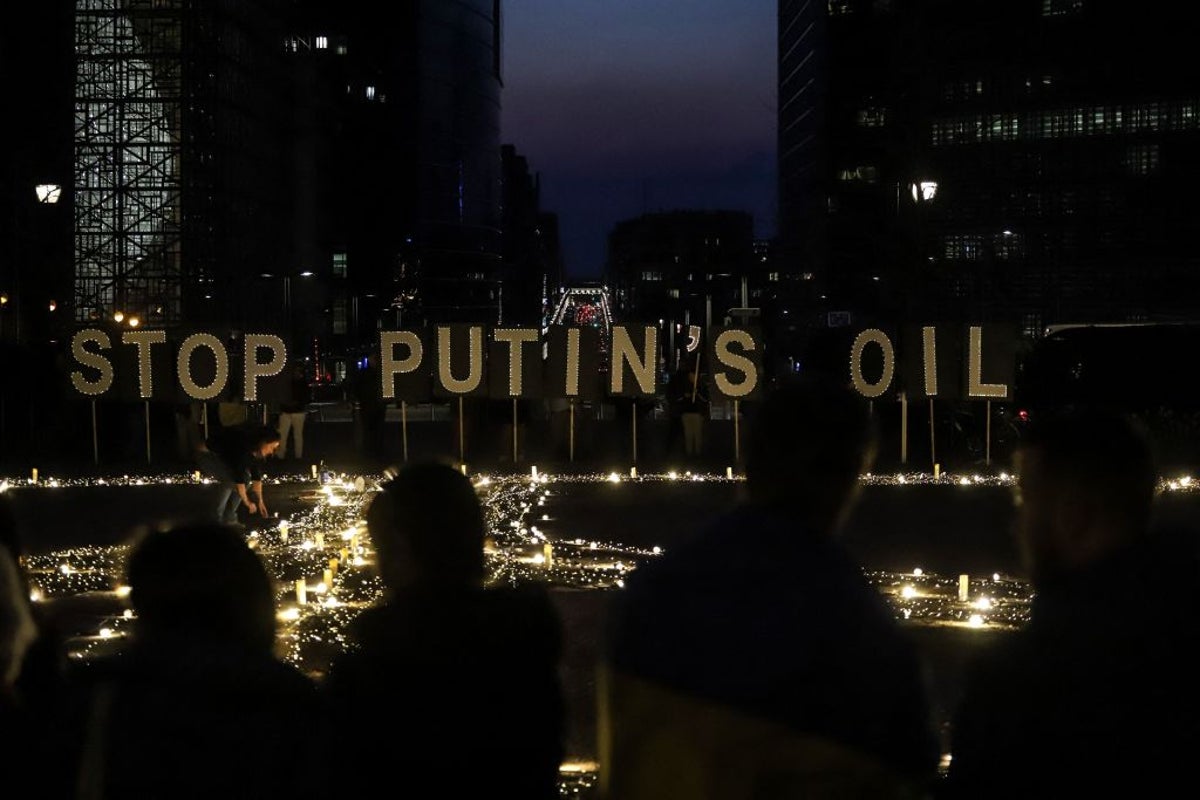Business
Which countries buy Russian oil – and what impact will sanctions have?

The US has this week imposed new sanctions on Rosneft and Lukoil, Russia’s two largest petroleum-producing companies.
After efforts to negotiate an end to Vladimir Putin’s war on Ukraine appeared to come to a standstill, the Trump administration made the move in a bid to “increase pressure on Russia’s energy sector” and “degrade the Kremlin’s ability to raise revenue for its war machine and support its weakened economy”.
So how much impact could the move have, and what are the implications for countries who rely on Russia to supply their oil?
Who buys oil from Russia?
China, India and Turkey are the biggest recipients of Russian oil that used to go to the European Union. The EU’s decision to boycott most Russian seaborne oil from January 2023 led to a massive shift in crude flows from Europe to Asia.
Since then, China has been the No 1 overall consumer of Russian energy, having purchased some $219.5bn (£164bn) worth of Russian oil, gas and coal, followed by India ($133.4bn/£100bn) and Turkey ($90.3bn/£67.7bn).
Up to 20 per cent of China’s crude oil imports come from Russia, Bloomberg reports, with data analytics firm Kpler suggesting that a quarter of that comes from Rosneft and Lukoil.
Last year, China reportedly bought 100 million tonnes of Russia crude, and last month alone it imported around 2 million barrels per day.

India is another country that makes significant purchases of Russian oil, having imported relatively little before the invasion of Ukraine. Now it imports around 1.6 million barrels a day.
Turkey is also a relatively big customer, while other purchasers include the EU, Myanmar and Azerbaijan, but it’s the deals with India and China that have the most outsized financial impact.
Analysis undertaken by the Centre for Research on Energy and Clean Air (CREA) showed the EU purchasing larger volumes of LNG and pipeline gas, while Turkey bought more oil products.
CREA analysis found that China and India had bought 85 per cent of all Russian crude oil exports in September.
Will the UK be affected?
The import, acquisition, and supply of Russian oil and oil products was banned by the UK in December 2022. However, the Treasury committee heard from experts in 2024 that Russian oil is still ending up in the UK despite sanctions, thanks to a loophole.
As long as Russian oil is refined in another country, such as India, it can avoid the ban.
Richard Bronze, head of geopolitics at Energy Aspects, told MPs that he estimated refined Russian oil to account for “well below 5 per cent” of the UK’s oil imports.
The UK joined the US in sanctioning Rosneft and Lukoil earlier this week.
What financial impact will the sanctions have?
As for how much of a hit Russia will take as a result of the new measures, the financial pinch may not be immediate.
The sanctions state that trade relations with the two Russian companies must be exited or closed by 21 November, giving India and China time to make alternative arrangements – and of course there’s the prospect that Russia will re-engage with talks during that time, in a bid to have the sanctions lifted.
However, CREA analysis showedthat Russia’s total revenue from fossil fuels in September was €546m (£474m) per day. The report also states that, if the $47.60 per barrel price cap had been fully enforced, that revenue would have been €1.53bn (£1.15bn) lower in September 2025 alone.
The most immediate impact has been a change in the price of oil. Markets typically do not like uncertainty, and the sanctions themselves were unexpected, so a quick upturn is not unusual in such circumstances.

“Oil markets have spiked higher after news emerged that the US was putting Russia’s major oil producers under sanctions due to the Kremlin’s failure to move toward peace in Ukraine,” said Steve Clayton, head of equity funds at Hargreaves Lansdown.
“Brent crude has climbed 4 per cent to almost $65 per barrel on the news, marking a dramatic recovery from recent weakness in crude markets. America’s new stance is in stark contrast to recent messaging from the White House and took markets by surprise.
“The effectiveness of the sanctions is yet to be proven, but President Trump has said that the Indian PM Narendra Modi has assured him that India will cease Russian oil purchases.”
For some context, Brent crude rose to around $77 earlier in the summer, when there were fears that Iran could entirely close the Strait of Hormuz.
How big are Rosneft and Lukoil?
The two organisations together represent about $105bn (£80bn) combined in market capitalisation – an accepted measure of the “worth” of a company – which is almost equally split, with Rosneft’s share being slightly larger. For comparison, London-listed energy firm BP is worth around £66bn.
Russia exports about 4 million barrels of oil a day, and Rosneft and Lukoil account for around half of that figure. Rosneft alone is responsible for roughly 6 per cent of global oil production.
Business
Will scrap Adani power deal if graft is proved: Bangladesh – The Times of India

DHAKA: Bangladesh will not hesitate to cancel a 2017 power contract with India’s Adani group if any irregularities or corruption are proven, said the Muhammad Yunus-led interim government, referring to an interim report that claimed “massive governance failure” and “massive corruption” across the energy sector.The report was submitted by the national review committee, established to review power sector contracts signed during the Sheikh Hasina governmet. Its chief, retired HC judge Moinul Islam Chowdhury, said Sunday “we found massive corruption, collusion, fraud, irregularities and illegalities”.While contracts affirm no corruption has taken place, cancellation remains possible if evidence proves otherwise, said power, energy and mineral resources adviser Muhammad Fouzul Kabir Khan at a press conference Sunday, following a meeting with the panel. “Verbal assurances won’t be accepted by courts; there must be proper justification,” he added.The 25-year deal between Adani Power and Bangladesh Power Development Board – which obliges Bangladesh to buy 100% of electricity generated by Adani’s 1,600 MW coal-fired power plant in Jharkhand – had come in for scrutiny after Hasina govt’s ouster. The plant was built to supply power exclusively to Bangladesh via a cross-border transmission line.Committee member Mushtaq Husain Khan said because it is a sovereign contract, it can’t be terminated arbitrarily. Cancelling such agreements could expose Bangladesh to substantial financial penalties from international arbitration courts, he said.
Business
Third-quarter earnings are indicating a divided economy

A Taco Bell restaurant in El Cerrito, California, US, on Tuesday, April 29, 2025.
David Paul Morris | Bloomberg | Getty Images
With more consumer companies preparing to report third-quarter earnings this week, Wall Street will be watching for signs of a bifurcated or “K-shaped” economy as consumers diverge in their spending behaviors.
There have been increasing signals that wealthier Americans are spending more while lower-income Americans are significantly paring back their spending. Lower-income consumers have been hit hardest by rising inflation and escalating prices on essentials, with September’s consumer price index report indicating a 0.3% increase on the month, putting the annual inflation rate at 3%.
Shortly after the CPI report was released, the Federal Reserve on Wednesday approved its second straight interest rate cut, lowering its benchmark overnight borrowing rate to a range of 3.75% to 4%.
Meanwhile, the country is entering the fifth week of the government shutdown, with many federal workers going without pay.
The Census Bureau estimated there were 35.9 million people in poverty in 2024, the most recent available data, with the weighted average poverty threshold for a family of four coming in at $32,130. The median household income, meanwhile was $83,730 last year, according to the bureau.
The top 10% of households saw their income increase 4.2% between 2023 and 2024, but there was no meaningful change for the bottom 10% of households, the bureau said in September. There were approximately 33 million households in the top 10% of earners and another 33 million in the bottom 10% of earners as of last year.
Consumers with the highest purchasing power have benefited from stock market rallies and rising home values. Data from JPMorgan‘s Cost of Living Survey found that higher-income consumers reported stronger economic confidence readings for the next year.
Recent earnings reports from companies touching all corners of the economy have indicated the K-shaped trend is beginning to take hold. This week, companies like Yum Brands, McDonald’s, E.l.f. Beauty, Tapestry and Under Armour are preparing to release quarterly earnings reports and could report similar trends.
Last week, Chipotle reported it’s seeing consumers who make less than $100,000 a year, which represents roughly 40% of the company’s customer base, spending less frequently due to concerns about the economy and inflation. CEO Scott Boatwright said the company is seeing “consistent macroeconomic pressures” with a 0.8% decline in traffic for the quarter.
Coca-Cola said in its third-quarter earnings that pricier products like Topo Chico sparkling water and Fairlife protein shakes are driving its growth. Procter & Gamble reported similar results, saying wealthier customers are buying more from club retailers, which sell bigger pack sizes, while lower-income shoppers are significantly pulling back.
And some of the companies reporting this week have already indicated they may be seeing similar behaviors. In early September, McDonald’s CEO Chris Kempczinski told CNBC’s “Squawk Box” that the chain’s expansion of its value menu was due to a “two-tier economy.”
“Traffic for lower-income consumers is down double digits, and it’s because people are either choosing to skip a meal … or they’re choosing to just eat at home,” he said.
The trend isn’t limited to just food and beverage, either. In the autos world, consumers who can afford to buy new vehicles are on a spree, while those who are more price constrained are sitting out. Defaults and repossessions are on the rise while the average price for a new vehicle is setting records.
And in the service industry, Hilton earlier this month reported that it saw a drop in revenue for its affordable brands while its luxury offerings performed exceedingly well. Still, CEO Christopher Nassetta told CNBC last month that he doesn’t expect bifurcation to last much longer.
“My own belief is that as we look into the fourth quarter and particularly into next year, we’re going to see a very big shift in those dynamics, meaning, I don’t think you’re going to continue to have this bifurcation,” Nassetta said. “That’s not to say I think the high end is going to get worse or bad. I just think the middle and the low end [are] going to move up.”
Correction: This article has been updated to correct the month of the CPI report.
Business
More than 55,000 UK firms in severe distress, research shows

More than 55,000 UK companies are in serious financial distress and in danger of collapse without improvement over the coming year, according to research.
Experts have warned that the upcoming autumn Budget “must deliver urgent support to avoid a wave of failures”, particularly among small businesses.
The latest quarterly Red Flag Alert report by Begbies Traynor has revealed a 78% jump in the number of firms in “critical” financial distress to 55,530 in the third quarter of 2025, compared with a year earlier.
It said this also represented a 12.6% jump against the quarter to June, showing a sharply worsening situation for more than 6,000 businesses.
Consumer-facing businesses have come under particular threat in recent months, as they face pressure from rising labour costs and an uptick in inflation.
The data showed there was a 96.7% jump in leisure and cultural firms in a “critical” situations, with a 92.5% rise in hotels and accommodation, and 85.6% rise for retailers.
Begbies Traynor also found that the number of firms in “significant” financial distress increased by 14.8% year-on-year to 726,594 for the latest quarter.
It comes amid fears that the Chancellor Rachel Reeves could turn to tax increases to help address the fiscal black hole in the UK’s state finances.
Julie Palmer, partner at Begbies Traynor, said the woes of many UK businesses “shows the UK economy is in real trouble”.
She added: “With over 55,000 companies now in serious financial distress, the upcoming Budget must deliver urgent support to avoid a wave of failures, especially among SMEs already operating on a knife edge.
“Unfortunately for UK businesses, inflation is going nowhere, putting further pressure on companies at a time when wage, tax, and financing costs are already high.
“Many firms have no room to manoeuvre, and instead of investing for growth, are scaling back just to survive – the opposite of what the economy needs, if it’s going to recover and grow.”
-

 Tech6 days ago
Tech6 days agoOpenAI says a million ChatGPT users talk about suicide
-

 Tech6 days ago
Tech6 days agoHow digital technologies can support a circular economy
-

 Tech6 days ago
Tech6 days agoUS Ralph Lauren partners with Microsoft for AI shopping experience
-

 Tech6 days ago
Tech6 days agoAI chatbots are becoming everyday tools for mundane tasks, use data shows
-

 Fashion6 days ago
Fashion6 days agoITMF elects new board at 2025 Yogyakarta conference
-

 Fashion1 week ago
Fashion1 week agoJapan’s textile trade shows strong apparel demand, weak yarn imports
-

 Business6 days ago
Business6 days agoTransfer test: Children from Belfast low income families to be given free tuition
-

 Entertainment1 week ago
Entertainment1 week agoGrimes backs Selena Gomez after ‘In The Dark’ video






